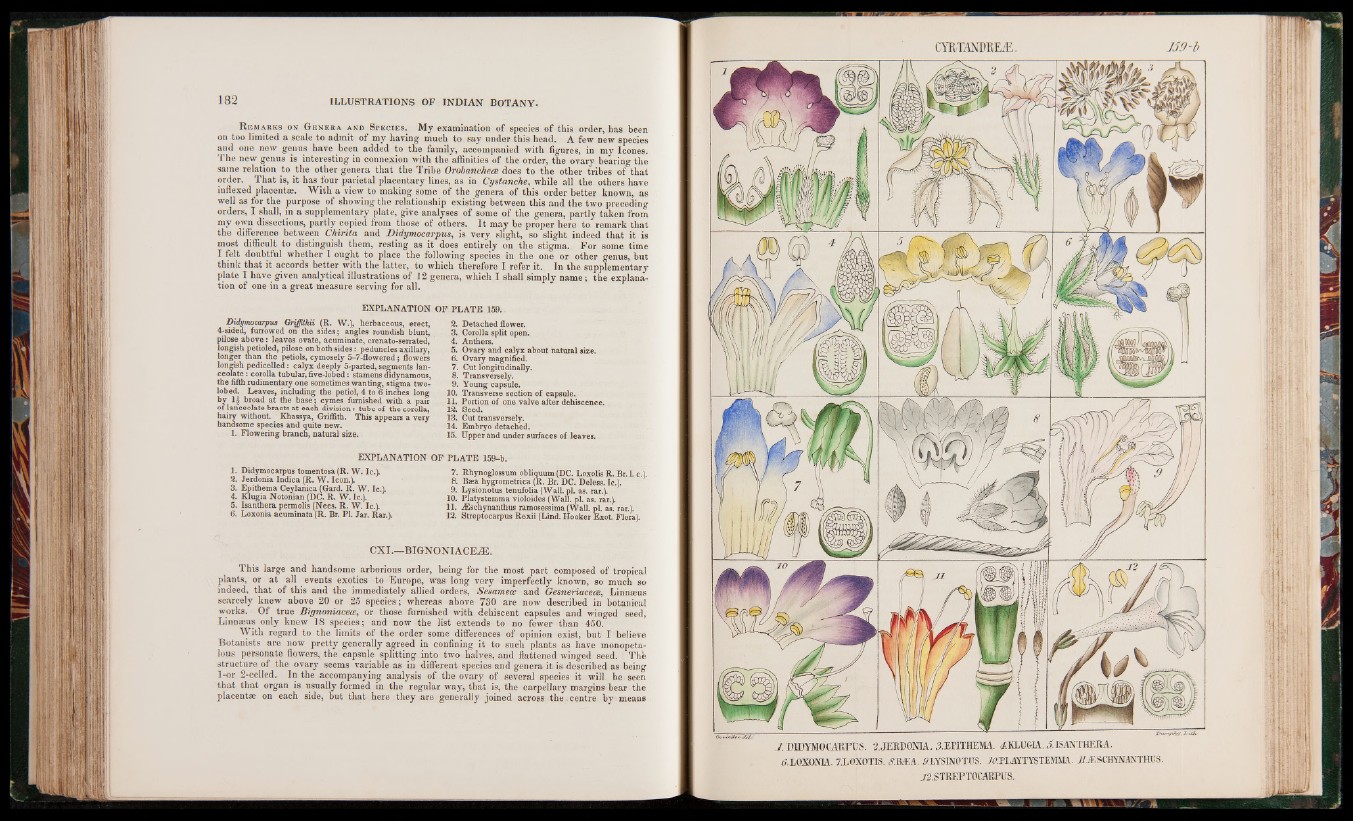
R emarks on Genera and Species. My examination of species of this order, has been
on too limited a scale to admit of my having much to say under this head. A few new species
and one new genus have been added to the family, accompanied with figures, in my leones.
The new genus is interesting in connexion with the affinities of the order, the ovary bearing the
same relation to the other genera that the Tribe Orobanchece does to the other tribes of that
order. That is, it has four parietal placentary lines, as in Cystanche, while all the others have
indexed placentas. With a view to making some of the genera of this order better known, as
well as for the purpose of showing the relationship existing between this and the two preceding
orders, I shall, in a supplementary plate, give analyses of some of the genera, partly taken from
my own dissections, partly copied from those of others. I t may be proper here to remark that
the difference between Chirita and Didymocarpus, is very slight, so slight indeed that it is
most difficult to distinguish them, resting as it does entirely on the stigma. For some time
I felt doubtful whether I ought to place the following species in the one or other genus, but
think that it accords better with the latter, to which therefore I refer it. In the supplementary
plate I have given analytical illustrations of J2 genera, which I shall simply name; the explanation
of one in a great measure serving for all.
EXPLANATION OF PLATE 159.
Didymocarpus Griffithii (R. W.), herbaceous, erect,
4-sided, furrowed on the sides; angles roundish blunt,
pilose above: leaves ovate, acuminate, crenato-serrated,
longish petioled, pilose on both sides: peduncles axillary,
longer than the petiols, cymosely 5-7-flowered; flowers
longish pedicelled: calyx deeply 5-parted, segments lanceolate
: corolla tubular, five-lobed: stamens didynamous,
the fifth rudimentary one sometimes wanting, stigma two-
lobed. Leaves, including the petiol, 4 to 6 inches long
by 1 | broad at the base; cymes furnished with a pair
o f lanceolate bracts at each division: tube of the corolla,
hairy without. Khassya, Griffith. This appears a very
handsome species and quite new.
1. Flowering branch, natural size.
2. Detached flower.
3. Corolla split open.
4. Anthers.
5. Ovary and calyx about natural size.
6. Ovary magnified.
7. Cut longitudinally.
8. Transversely.
9. Young capsule.
10. Transverse section of capsule.
11. Portion of one valve after dehiscence.
12. Seed.
13. Cut transversely.
14. Embryo detached.
15. Upper and under surfaces of leaves.
EXPLANATION OF PLATE 159-b.
1. Didymocarpus tomentosa (R. W. Ic.).
2. Jerdonia Indica (R. W. Icon.).
3. Epithema Ceylanica (Gard. R. W. Ic .l
4. Rlugia Notonian (DC. R. W. Ic.).
5. Isanthera permolis (Nees. R. W. Ic.).
6. Loxonia acuminata (R. Br. PI. Jar. Rar.).
7. Rhynoglossum obliquum (DC. Loxolis R. Br. 1. c.).
8. Bæa hygrometrica (R. Br. DC. Deless. Ic.).
9. Lysionotus tenufolia (Wall. pi. as. rar.).
10. Platystemma violoides (Wall. pi. as. rar.).
11. Æschynanthus ramosessima(Wall. pi. as. rar.).
12. Streptocarpus Rexii (Lind. Hooker Exot. Flora).
CXI.—BIGNONIACE.AC.
This large and handsome arborious order, being for the most part composed of tropical
plants, or at all events exotics to Europe, was long very imperfectly known, so much so
indeed, that of this and the immediately allied orders, Sesamecs and Gesneriacece, Linn ecus
scarcely knew above 20 or 25 species; whereas above 730 are now described in botanical
works. Of true Bignoniacece, or those furnished with dehiscent capsules and winged seed,
Linnaeus only knew 18 species; and now the list extends to no fewer than 450.
With regard to the limits of the order some differences of opinion exist, but I believe
Botanists are now pretty generally agreed in confining it to such plants as have monopeta-
lous personate flowers, the capsule splitting into two halves, and flattened winged seed. The
structure of the ovary seems variable as in different species and genera it is described as being
1-or 2-celled. In the accompanying analysis of the ovary of several species it will be seen
that that organ is. usually formed in the regular way, that is, the carpellary margins bear the
placentae on each side, but that here they are generally joined across the .centre by means
CYMANTOEÆ.
J. DIDYMOCARPUS. 2. JERDONIA. 3.EFITHEMA. 7.KLUGIA. 5.ISANTHERA.
tf.LOXONM. 7X0X0TIS. S3ÆA. ÆLYSINOTUS. 70.PIAYTYSTEMMA. 7/ÆSCHYNANTHUS.
72.STREPT0CARPUS.